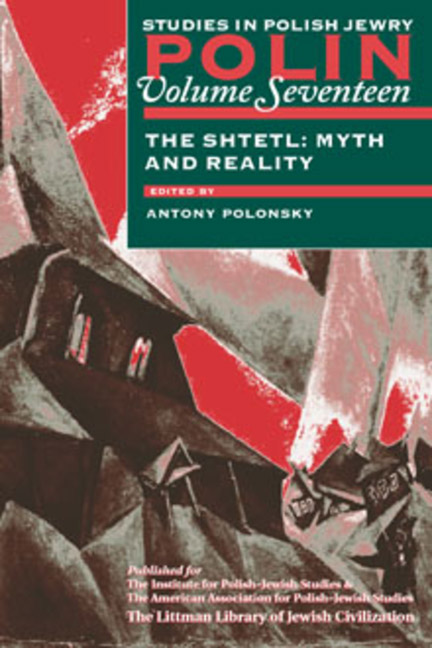Book contents
- Frontmatter
- Dedication
- Editors and Advisers
- Preface
- Polin
- Polin: Studies inPolish Jewry
- Contents
- Note on Place Names
- Note on Transliteration
- List of Abbreviations
- PART I THE SHTETL: MYTH AND REALITY
- Introduction. The Shtetl: Myth and Reality
- The Shtetl as an Arena for Polish–Jewish Integration in the Eighteenth Century
- Inter-Religious Contacts in the Shtetl: Proposals for Future Research
- The Hasidic Conquest of Small-Town Central Poland, 1754–1818
- The Drama of Berdichev: Levi Yitshak and his Town
- Polish Shtetls under Russian Rule, 1772–1914
- How Jewish Was the Shtetl?
- The Changing Shtetl in the Kingdom of Poland during the First World War
- The Shtetl: Cultural Evolution in Small Jewish Towns
- Small Towns in Inter-War Poland
- Jewish Patrons and Polish Clients: Patronage in a Small Galician Town
- Maintaining Borders, Crossing Borders: Social Relationships in the Shtetl
- The Soviet Shtetl in the 1920s
- Shtetl and Shtot in Yiddish Haskalah Drama
- Kazimierz on the Vistula: Polish Literary Portrayals of the Shtetl
- Imagining the Image: Interpretations of the Shtetl in Yiddish Literary Criticism
- Shtetl Codes: Fantasy in the Fiction of Asch, Schulz, and I. B. Singer
- Returning to the Shtetl: Differing Perceptions
- PART II NEW VIEWS
- PART III DOCUMENTS
- PART IV THE SIXTY-FIFTH ANNIVERSARY OF EVENTS IN PRZYTYK: A DEBATE
- PART V REVIEWS
- OBITUARIES
- Notes on the Contributors
- Glossary
- Index
Returning to the Shtetl: Differing Perceptions
from PART I - THE SHTETL: MYTH AND REALITY
- Frontmatter
- Dedication
- Editors and Advisers
- Preface
- Polin
- Polin: Studies inPolish Jewry
- Contents
- Note on Place Names
- Note on Transliteration
- List of Abbreviations
- PART I THE SHTETL: MYTH AND REALITY
- Introduction. The Shtetl: Myth and Reality
- The Shtetl as an Arena for Polish–Jewish Integration in the Eighteenth Century
- Inter-Religious Contacts in the Shtetl: Proposals for Future Research
- The Hasidic Conquest of Small-Town Central Poland, 1754–1818
- The Drama of Berdichev: Levi Yitshak and his Town
- Polish Shtetls under Russian Rule, 1772–1914
- How Jewish Was the Shtetl?
- The Changing Shtetl in the Kingdom of Poland during the First World War
- The Shtetl: Cultural Evolution in Small Jewish Towns
- Small Towns in Inter-War Poland
- Jewish Patrons and Polish Clients: Patronage in a Small Galician Town
- Maintaining Borders, Crossing Borders: Social Relationships in the Shtetl
- The Soviet Shtetl in the 1920s
- Shtetl and Shtot in Yiddish Haskalah Drama
- Kazimierz on the Vistula: Polish Literary Portrayals of the Shtetl
- Imagining the Image: Interpretations of the Shtetl in Yiddish Literary Criticism
- Shtetl Codes: Fantasy in the Fiction of Asch, Schulz, and I. B. Singer
- Returning to the Shtetl: Differing Perceptions
- PART II NEW VIEWS
- PART III DOCUMENTS
- PART IV THE SIXTY-FIFTH ANNIVERSARY OF EVENTS IN PRZYTYK: A DEBATE
- PART V REVIEWS
- OBITUARIES
- Notes on the Contributors
- Glossary
- Index
Summary
THE longing to ‘return’ to one's past, to the sights and smells of one's childhood and youth, is as old as human culture. The yearning for paradise lost, the homecoming of Odysseus, and the artistic return of Proust to his childhood are some of the most appreciated versions of this universal phenomenon. When speaking of modern Jewish ‘returns’ in particular, Shmuel Yosef Agnon comes immediately to mind. In his autobiographical novel Ore'aḥ nata lalun (‘A Guest for the Night’) he dwells on the protagonist's return to his invented home town of Shibosh—the actual Buczacz in eastern Galicia. Agnon made his own return to Buczacz in the summer of 1930, more than twenty years after he had left it. Not surprisingly, what he encountered there was quite different from what he remembered.
Agnon's stay in Buczacz was both euphoric and traumatic. On the one hand, he experienced the excitement of revisiting the sites of his childhood, and on the other, he endured the trauma of witnessing the disintegration of the Jewish shtetl. Indeed, Agnon's description of Shibosh–Buczacz captures above all the deterioration of Jewish life in Poland on the eve of the Holocaust. One can also sense in the work the vague and strange presence of an impending catastrophe. Emuna Yaron, Agnon's daughter and the compiler and editor of many of his works, visited Buczacz sixtysix years later. When she arrived, there was nothing left of the bustling Jewish life and culture that had once existed there. Of the thousands of Jews who had lived in Buczacz, only two or three were left, and these were not keen to be identified as Jews. For Emuna, as for her father back in 1930, it was both a sentimental and a depressing experience. However, she did find some solace in locating tangible traces of her ancestors’ lives there; she was satisfied to walk down the streets and recognize the sights that her father had so eloquently described.
Czesław Miłosz has noted that ‘An enormous exodus of populations from East to West occurred as a result of the Second World War.’ Indeed, no previous period in modern history has witnessed such a massive displacement of people from their homelands and birthplaces.
- Type
- Chapter
- Information
- The Shtetl: Myth and Reality , pp. 267 - 276Publisher: Liverpool University PressPrint publication year: 2004



